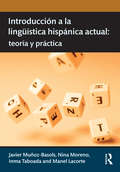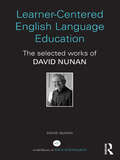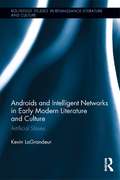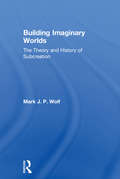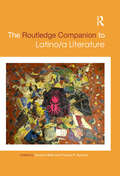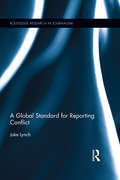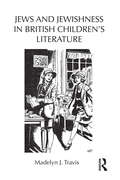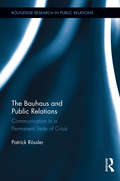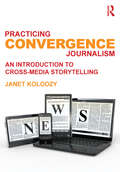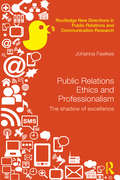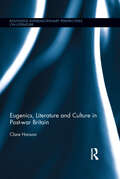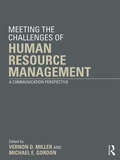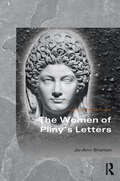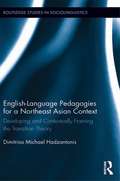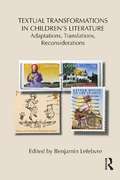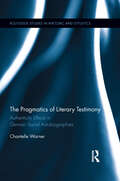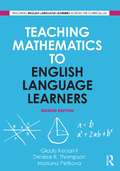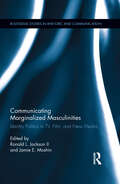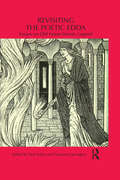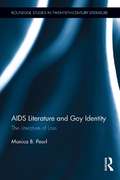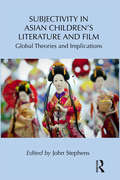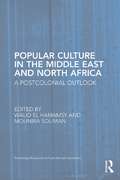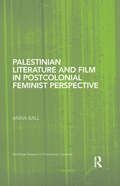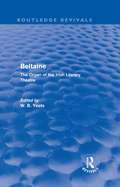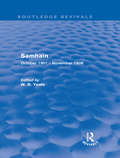- Table View
- List View
Introducción a la lingüística hispánica actual: teoría y práctica
by Javier Muñoz-Basols Manel Lacorte Nina Moreno Taboada InmaIntroducción a la lingüística hispánica actual is the ideal introduction to Spanish linguistics for all undergraduate and postgraduate students of Spanish. No prior knowledge of linguistics is assumed as the book takes you step-by-step through all the main subfields of linguistics, both theoretical and applied. Phonology. morphology, syntax, semantics, pragmatics, second language acquisition, history of the Spanish language, dialectology and sociolinguistics are concisely and accurately outlined providing a comprehensive foundation in the field. A comprehensive companion website provides a wealth of additional resources including further exercises to reinforce the material covered in the book, extra examples to clarify the most difficult concepts, extensive audio clips which reproduce the sounds of phonemes and allophones and sonograms. Written in a clear and accessible manner with extensive auxiliary materials, Introducción a la lingüística hispánica actual has been specially designed for students of Spanish with little or no linguistic background who need to understand the key concepts and constructs of Spanish linguistics.
Learner-Centered English Language Education: The Selected Works of David Nunan
by David NunanThis carefully crafted collection provides a snapshot of the evolution of David Nunan‘s theoretical and empirical contributions to the field of second language education over the last 40 years. The volume focuses on the development of his work on second language curricula, and in particular, the work for which he is best known: learner-centered education and task-based learning and teaching. David Nunan has been a language teacher, researcher and consultant for 40 years. He has lived and worked in many countries, principally in the Asia-Pacific region, but also in the Americas, Europe and the Middle-East. In addition to his research and scholarly work, he is the author of several major textbook series for the teaching and learning of English as a foreign Language. These texts are based on his task-based language teaching approach, and are widely used in schools, school systems and universities around the world.
Androids and Intelligent Networks in Early Modern Literature and Culture: Artificial Slaves (Routledge Studies in Renaissance Literature and Culture)
by Kevin LaGrandeurAwarded a 2014 Science Fiction and Technoculture Studies Prize Honourable Mention. This book explores the creation and use of artificially made humanoid servants and servant networks by fictional and non-fictional scientists of the early modern period. Beginning with an investigation of the roots of artificial servants, humanoids, and automata from earlier times, LaGrandeur traces how these literary representations coincide with a surging interest in automata and experimentation, and how they blend with the magical science that preceded the empirical era. In the instances that this book considers, the idea of the artificial factotum is connected with an emotional paradox: the joy of self-enhancement is counterpoised with the anxiety of self-displacement that comes with distribution of agency.In this way, the older accounts of creating artificial slaves are accounts of modernity in the making—a modernity characterized by the project of extending the self and its powers, in which the vision of the extended self is fundamentally inseparable from the vision of an attenuated self. This book discusses the idea that fictional, artificial servants embody at once the ambitions of the scientific wizards who make them and society’s perception of the dangers of those ambitions, and represent the cultural fears triggered by independent, experimental thinkers—the type of thinkers from whom our modern cyberneticists descend.
Building Imaginary Worlds: The Theory and History of Subcreation
by Mark J.P. WolfMark J.P. Wolf’s study of imaginary worlds theorizes world-building within and across media, including literature, comics, film, radio, television, board games, video games, the Internet, and more. Building Imaginary Worlds departs from prior approaches to imaginary worlds that focused mainly on narrative, medium, or genre, and instead considers imaginary worlds as dynamic entities in and of themselves. Wolf argues that imaginary worlds—which are often transnarrative, transmedial, and transauthorial in nature—are compelling objects of inquiry for Media Studies. Chapters touch on: a theoretical analysis of how world-building extends beyond storytelling, the engagement of the audience, and the way worlds are conceptualized and experienced a history of imaginary worlds that follows their development over three millennia from the fictional islands of Homer’s Odyssey to the present internarrative theory examining how narratives set in the same world can interact and relate to one another an examination of transmedial growth and adaptation, and what happens when worlds make the jump between media an analysis of the transauthorial nature of imaginary worlds, the resulting concentric circles of authorship, and related topics of canonicity, participatory worlds, and subcreation’s relationship with divine Creation Building Imaginary Worlds also provides the scholar of imaginary worlds with a glossary of terms and a detailed timeline that spans three millennia and more than 1,400 imaginary worlds, listing their names, creators, and the works in which they first appeared.
The Routledge Companion to Latino/a Literature (Routledge Literature Companions)
by Suzanne Bost Frances R. AparicioLatino/a literature is one of the fastest developing fields in the discipline of literary studies. It represents an identity that is characterized by fluidity and diversity, often explored through divisions formed by language, race, gender, sexuality, and immigration. The Routledge Companion to Latino/a Literature presents over forty essays by leading and emerging international scholars of Latino/a literature and analyses: Regional, cultural and sexual identities in Latino/a literature Worldviews and traditions of Latino/a cultural creation Latino/a literature in different international contexts The impact of differing literary forms of Latino/a literature The politics of canon formation in Latino/a literature. This collection provides a map of the critical issues central to the discipline, as well as uncovering new perspectives and new directions for the development of the field. It is essential reading for anyone interested in the past, present and future of this literary culture.
A Global Standard for Reporting Conflict (Routledge Research in Journalism)
by Jake LynchA Global Standard for Reporting Conflict constructs an argument from first principles to identify what constitutes good journalism. It explores and synthesises key concepts from political and communication theory to delineate the role of journalism in public spheres. And it shows how these concepts relate to ideas from peace research, in the form of Peace Journalism. Thinkers whose contributions are examined along the way include Michel Foucault, Johan Galtung, John Paul Lederach, Edward Herman and Noam Chomsky, Manuel Castells and Jurgen Habermas. The book argues for a critical realist approach, considering critiques of ‘correspondence’ theories of representation to propose an innovative conceptualisation of journalistic epistemology in which ‘social truths’ can be identified as the basis for the journalistic remit of factual reporting. If the world cannot be accessed as it is, then it can be assembled as agreed – so long as consensus on important meanings is kept under constant review. These propositions are tested by extensive fieldwork in four countries: Australia, the Philippines, South Africa and Mexico.
Jews and Jewishness in British Children's Literature (Children's Literature and Culture)
by Madelyn TravisIn a period of ongoing debate about faith, identity, migration and culture, this timely study explores the often politicised nature of constructions of one of Britain’s longest standing minority communities. Representations in children’s literature influenced by the impact of the Enlightenment, the Empire, the Holocaust and 9/11 reveal an ongoing concern with establishing, maintaining or problematising the boundaries between Jews and Gentiles. Chapters on gender, refugees, multiculturalism and historical fiction argue that literature for young people demonstrates that the position of Jews in Britain has been ambivalent, and that this ambivalence has persisted to a surprising degree in view of the dramatic socio-cultural changes that have taken place over two centuries. Wide-ranging in scope and interdisciplinary in approach, Jews and Jewishness in British Children’s Literature discusses over one hundred texts ranging from picture books to young adult fiction and realism to fantasy. Madelyn Travis examines rare eighteenth- and nineteenth-century material plus works by authors including Maria Edgeworth, E. Nesbit, Rudyard Kipling, Richmal Crompton, Lynne Reid Banks, Michael Rosen and others. The study also draws on Travis’s previously unpublished interviews with authors including Adele Geras, Eva Ibbotson, Ann Jungman and Judith Kerr.
The Bauhaus and Public Relations: Communication in a Permanent State of Crisis (Routledge Research in Public Relations)
by Patrick RösslerThis innovative study considers one of the most important art and design movements of the 20th century, the Bauhaus, in conjunction with current research in public relations and organizational communication, elaborating on the mechanisms of internal and external communication available to influence the stakeholders in politics, society, industry, and the art world. In a movement where a substantial share of productivity ran in measures to highlight the public value of the institution funded by the taxpayer, the directors, and other persons in charge, the Bauhaus developed comprehensive strategies to communicate their messages to a variety of target groups such as politicians and economic leaders, intellectuals and other artists, current and prospective students, and the general public. To achieve this goal, the Bauhaus anticipated many instruments of modern public relations and corporate communications, including press releases, staging of events, media publications, community building, lobbying, and the creation of nationwide public presence. Rössler argues that as an organization, the Bauhaus cultivated corporate behavior and, most prominently, a corporate design which unfolded revolutionary power. The basic achievements of new typography (a label coined at the Bauhaus) determine visual communication to this day, while the Bauhaus moved from an institutional organization to a community. Beginning with an overview of the Bauhaus’ corporate identity and a close examination of the respective directors’ roles for internal and external communication, this book visits exhibitions, events, and the media attention they evoked in newspapers and contemporary periodicals, along with media products designed at the Bauhaus such as magazines, books, and bank notes.
Practicing Convergence Journalism: An Introduction to Cross-Media Storytelling
by Janet KolodzyPracticing Convergence Journalism teaches budding journalists how to make the most of digital technology to tell their stories effectively across multiple media platforms—in print, audio, video and online. Janet Kolodzy addresses multi-media and cross-media thinking, organizing, reporting and producing for both short-form spot news and long-form features. Her approach focuses on storytelling principles, not just specific technical practices, providing journalists with the mindset and skills they need to adapt their writing and reporting for the tools of today and tomorrow. With this book and the aid of its companion website, students learn how to: Develop a cross-media mode of journalistic thinking that will result in stories suitable for a fast-paced, multitasking and mobile audience. Decide when visuals are useful and necessary, and understand how to capture, select and organize them to effectively enhance a reader’s understanding of a story. Put together various elements of storytelling (writing, audio, moving and still pictures) for an interactive journalistic experience.
Public Relations Ethics and Professionalism: The Shadow of Excellence (Routledge New Directions in PR & Communication Research)
by Johanna FawkesDo professions really place duty to society above clients' or their own interests? If not, how can they be trusted? While some public relations (PR) scholars claim that PR serves society and enhances the democratic process, others suggest that it is little more than propaganda, serving the interests of global corporations. This is not an argument about definitions, but about ethics - yet this topic is barely explored in texts and theories that seek to explain PR and its function in society. This book places PR ethics in the wider context of professional ethics and the sociology of professions. By bringing together literature from fields beyond public relations - sociology, professional and philosophical ethics, and Jungian psychology - it integrates a new body of ideas into the debate. The unprecedented introduction of Jungian psychology to public relations scholarship shifts the debate beyond a traditional Western 'Good/Bad' ethical dichotomy towards a new holistic approach, with dynamic implications for theory and practice. This thought-provoking book will be essential reading for students, academics and professionals with an interest in public relations, ethics and professionalism.
Eugenics, Literature, and Culture in Post-war Britain (Routledge Interdisciplinary Perspectives on Literature)
by Clare HansonThis book explores eugenics in its wider social context and in literary representations in post-war Britain. Drawing on a wide range of sources in medicine, social and educational policy, genetics, popular science, science fiction, and literary texts, Hanson tracks the dynamic interactions between eugenic ideas across diverse cultural fields, demonstrating the strength of the eugenic imagination. Challenging assumptions that eugenics was fatally compromised by its association with Nazi atrocities, or that it petered out in the context of changed social attitudes in an egalitarian post-war society, the book demonstrates that eugenic thought not only persisted after 1945, but became more prominent. Throughout, eugenics is defined as a cultural movement, rather than more narrowly as a science, and the study is focused on its border-crossing capacity as a ‘style of thought.’ By tracing the expression of eugenic ideas across disciplinary boundaries and in both high and low culture, this book demonstrates the powerful and pervasive influence of eugenics in the post-war years. Authors visited include Raymond Williams, John Braine, Agatha Christie, Muriel Spark, Anthony Burgess, Doris Lessing, and J.G. Ballard.
Meeting the Challenge of Human Resource Management: A Communication Perspective
by Michael E. Gordon Vernon D. MillerWhile communicating is a vital skill for managers at all organizational levels and in all functional areas, human resource managers are expected to be especially adept communicators, given the important interpersonal component of their roles. Practitioners and scholars alike stand to benefit from incorporating an updated and more nuanced view of communication theory and practice into standard human resource management practices. This book compiles readings by thought leaders in human resource management and communication, exploring the intersection of interests, theories, and perspectives from the two fields to highlight new opportunities for research and practice. In addition to covering the foundations of strategic human resource management, the book: offers a critical review of the research literature on topics including recruitment, selection, performance management, compensation, and development uses a communication perspective to analyze the impact of corporate strategy on human resource systems investigates the key human resource management topic of the relationship between a company's human capital and its effectiveness directly discusses the implications of communication literature for human resource management practice Written at the cross-section of two established and critcally linked fields, this book is a must-have for graduate human resource management and organizational communication students, as well as for high-level human resource management practitioners.
The Women of Pliny's Letters (Women of the Ancient World)
by Jo-Ann SheltonPliny's letters offer a significant source of information about the lives of Roman women (predominantly, though not exclusively, upper-class women) during the late first and early second centuries CE. In the 368 letters included in his ten published books of epistles, Pliny mentions over 30 women by name, addresses letters to seven, and refers to well over 40 anonymous women. Many of the references are brief comments in letters whose topics are the activities of Pliny's male acquaintances. Nonetheless his letters inform us about the roles of women in Roman families, marriages, and households, and also record the involvement of women in such matters as court cases, property ownership, religious orders, social networks, and political activities. This book has two aims. The first is to bring these women to the foreground, to explore their kinships, relationships, and activities, and to illuminate their lives by viewing them in the social, cultural, and political environments of the period in which they lived. This book utilizes historical, literary, legal, and epigraphical sources to examine the events, circumstances, and attitudes that were the contexts for the lives of these women. The first aim, then, is to gain insight into the reality of their lives. The second aim of this book is to investigate how Pliny defines the ideal behavior for women. In his accounts of the actions of both women and men, Pliny frequently shapes his narratives to promote moral lessons. In several of his letters about women, he elevates his subject to the status of a role model. The second aim of this book is to use the descriptions provided by Pliny to acquire a better understanding of what behavior was admired in Roman women of this period, and to consider how the concept of the model Roman woman is constructed in Pliny.
English Language Pedagogies for a Northeast Asian Context: Developing and Contextually Framing the Transition Theory (Routledge Studies in Sociolinguistics)
by Michael HadzantonisThis book investigates, from a sociocultural, linguistic, and pedagogical perspective, the conceptual and pragmatic frameworks that characterize secondary language learning in a Northeast Asian context. Hadzantonis contextualizes these salient domains through an engagement with social and cultural themes such as the familial, political, as well as cultural commodities and socioeducational structures. In this way, the text employs tools such as transnational theory and performativity and develops a model that contributes to the resolution of one of the greatest economic issues of the time, that of ineffective secondary language learning.
Textual Transformations in Children's Literature: Adaptations, Translations, Reconsiderations (Children's Literature and Culture #87)
by Benjamin LefebvreThis book offers new critical approaches for the study of adaptations, abridgments, translations, parodies, and mash-ups that occur internationally in contemporary children’s culture. It follows recent shifts in adaptation studies that call for a move beyond fidelity criticism, a paradigm that measures the success of an adaptation by the level of fidelity to the "original" text, toward a methodology that considers the adaptation to be always already in conversation with the adapted text. This book visits children’s literature and culture in order to consider the generic, pedagogical, and ideological underpinnings that drive both the process and the product. Focusing on novels as well as folktales, films, graphic novels, and anime, the authors consider the challenges inherent in transforming the work of authors such as William Shakespeare, Charles Perrault, L.M. Montgomery, Laura Ingalls Wilder, and A.A. Milne into new forms that are palatable for later audiences particularly when—for perceived ideological or political reasons—the textual transformation is not only unavoidable but entirely necessary. Contributors consider the challenges inherent in transforming stories and characters from one type of text to another, across genres, languages, and time, offering a range of new models that will inform future scholarship.
The Pragmatics of Literary Testimony: Authenticity Effects in German Social Autobiographies (Routledge Studies in Rhetoric and Stylistics #4)
by Chantelle WarnerIn this book, Warner examines a number of German-language literary autobiographies that are connected to diverse social movements of the last forty years. These books have all received critical attention from the popular press, topped bestseller lists, and have been pivotal in discussions of authenticity, subjectivity, and referentiality. Because of the thematic diversity of these works, scholars within literary and cultural studies have tended to treat them separately under topical categories, such as women’s literature, the post-war generation, migration and multiculturalism, etc. Underlying Warner’s analysis is the belief that the social construction of autobiographical acts is as much a matter of textuality as it is of topicality i.e., how language means, rather than what it means, and that a pragmatic-stylistic approach is well-suited to describing how literary autobiographies come to function as testimonies to certain collective experiences. By presenting a model for an integrative stylistics approach, The Prgamatics of Literary Testimony participates in current discussions within fields of literary linguistic scholarship, as well as autobiographical theory. In its analysis of key examples of German social testimonies from the late twentieth century, this book incorporates insights from discourse analysis, pragmatics, cogntive poetics, and sociolinguistics in order to demonstrate that this diverse body of works constitutes a particular form of textual practice defined by what the author calls authenticity effects—feelings of realism, immediacy, exemplarity, genuineness, and social relevance. Such a study of authenticity as a poetic effect, can help us to better understand the testimonial glamour owned by various types of autobiographical narration.
Teaching Mathematics to English Language Learners
by Denisse R. Thompson Gladis Kersaint Mariana PetkovaToday's mathematics classrooms increasingly include students for whom English is a second language. Teaching Mathematics to English Language Learners provides readers a comprehensive understanding of both the challenges that face English language learners (ELLs) and ways in which educators might address them in the secondary mathematics classroom. Framed by a research perspective, Teaching Mathematics to English Language Learners presents practical instructional strategies for engaging learners that can be incorporated as a regular part of instruction. The authors offer context-specific strategies for everything from facilitating classroom discussions with all students, to reading and interpreting math textbooks, to tackling word problems. A fully annotated list of math web and print resources completes the volume, making this a valuable reference to help mathematics teachers meet the challenges of including all learners in effective instruction. Features and updates to this new edition include: An updated and streamlined Part 1 provides an essential overview of ELL theory in a mathematics specific context. Additional practical examples of mathematics problems and exercises make turning theory into practice easy when teaching ELLs New pedagogical elements in Part 3 include tips on harnessing new technologies, discussion questions and reflection points. New coverage of the Common Core State Standards, as well as updates to the web and print resources in Part 4.
Communicating Marginalized Masculinities: Identity Politics in TV, Film, and New Media (Routledge Studies in Rhetoric and Communication #11)
by Ronald L. Jackson II Jamie E. MoshinFor years, research concerning masculinities has explored the way that men have dominated, exploited, and dismantled societies, asking how we might make sense of marginalized masculinities in the context of male privilege. This volume asks not only how terms such as men and masculinity are socially defined and culturally instantiated, but also how the media has constructed notions of masculinity that have kept minority masculinities on the margins. Essays explore marginalized masculinities as communicated through film, television, and new media, visiting representations and marginalized identity politics while also discussing the dangers and pitfalls of a media pedagogy that has taught audiences to ignore, sidestep, and stereotype marginalized group realities. While dominant portrayals of masculine versus feminine characters pervade numerous television and film examples, this collection examines heterosexual and queer, military and civilian, as well as Black, Japanese, Indian, White, and Latino masculinities, offering a variance in masculinities and confronting male privilege as represented on screen, appealing to a range of disciplines and a wide scope of readers.
Revisiting the Poetic Edda: Essays on Old Norse Heroic Legend (Routledge Medieval Casebooks)
by Carolyne Larrington Paul AckerBringing alive the dramatic poems of Old Norse heroic legend, this new collection offers accessible, ground-breaking and inspiring essays which introduce and analyse the exciting legends of the two doomed Helgis and their valkyrie lovers; the dragon-slayer Sigurðr; Brynhildr the implacable shield-maiden; tragic Guðrún and her children; Attila the Hun (from a Norse perspective!); and greedy King Fróði, whose name lives on in Tolkien’s Frodo. The book provides a comprehensive introduction to the poems for students, taking a number of fresh, theoretically-sophisticated and productive approaches to the poetry and its characters. Contributors bring to bear insights generated by comparative study, speech act and feminist theory, queer theory and psychoanalytic theory (among others) to raise new, probing questions about the heroic poetry and its reception. Each essay is accompanied by up-to-date lists of further reading and a contextualisation of the poems or texts discussed in critical history. Drawing on the latest international studies of the poems in their manuscript context, and written by experts in their individual fields, engaging with the texts in their original language and context, but presented with full translations, this companion volume to The Poetic Edda: Essays on Old Norse Mythology (Routledge, 2002) is accessible to students and illuminating for experts. Essays also examine the afterlife of the heroic poems in Norse legendary saga, late medieval Icelandic poetry, the nineteenth-century operas of Richard Wagner’s Der Ring des Nibelungen, and the recently published (posthumous) poem by Tolkien, The Legend of Sigurd and Gudrún.
AIDS Literature and Gay Identity: The Literature of Loss (Routledge Studies in Twentieth-Century Literature)
by Monica B. PearlThis book discusses the significance of late twentieth century and early twenty first century American fiction written in response to the AIDS crisis and interrogates how sexual identity is depicted and constructed textually. Pearl develops Freudian psychoanalytic theory in a complex account of the ways in which grief is expressed and worked out in literature, showing how key texts from the AIDS crisis by authors such as Edmund White, Michael Cunningham, Eve Sedgwick – and also, later, the archives of The ACT UP Oral History Project - lie both within the tradition of gay writing and a postmodernist poetics. The book demonstrates how literary texts both expose and construct personal identity, how they expose and produce sexual identities, and how gay and queer identities were written onto the page, but also constructed and consolidated by these very texts. Pearl argues that the division between realist and postmodern, and gay and queer, respectively, is determined by whether the experience expressed and accounted is mediated through the psychoanalytic categories of mourning or melancholia, and is marked by a kind of coherence or chaos in the texts themselves. This study presents an important development in scholarly work in gay literary studies, queer theory, and AIDS representation.
Subjectivity in Asian Children's Literature and Film: Global Theories and Implications (Children's Literature and Culture)
by John StephensWinner of the Children’s Literature Association Honor Book Award This volume establishes a dialogue between East and West in children’s literature scholarship. In all cultures, children’s literature shows a concern to depict identity and individual development, so that character and theme pivot on questions of agency and the circumstances that frame an individual’s decisions and capacities to make choices and act upon them. Such issues of selfhood fall under the heading subjectivity. Attention to the representation of subjectivity in literature enables us to consider how values are formed and changed, how emotions are cultivated, and how maturation is experienced. Because subjectivities emerge in social contexts, they vary from place to place. This book brings together essays by scholars from several Asian countries — Japan, India, Pakistan, Korea, Vietnam, Taiwan, Australia, Thailand, and The Philippines — to address subjectivities in fiction and film within frameworks that include social change, multiculturalism, post-colonialism, globalization, and glocalization. Few scholars of western children's literature have a ready understanding of what subjectivity entails in children’s literature and film from Asian countries, especially where Buddhist or Confucian thought remains influential. This volume will impact scholarship and pedagogy both within the countries represented and in countries with established traditions in teaching and research, offering a major contribution to the flow of ideas between different academic and educational cultures.
Popular Culture in the Middle East and North Africa: A Postcolonial Outlook (Routledge Research in Postcolonial Literatures #46)
by Walid El Hamamsy Mounira SolimanThis book explores the body and the production process of popular culture in, and on, the Middle East and North Africa, Turkey, and Iran in the first decade of the 21st century, and up to the current historical moment. Essays consider gender, racial, political, and cultural issues in film, cartoons, music, dance, photo-tattoos, graphic novels, fiction, and advertisements. Contributors to the volume span an array of specializations ranging across literary, postcolonial, gender, media, and Middle Eastern studies and contextualize their views within a larger historical and political moment, analyzing the emergence of a popular expression in the Middle East and North Africa region in recent years, and drawing conclusions pertaining to the direction of popular culture within a geopolitical context. The importance of this book lies in presenting a fresh perspective on popular culture, combining media that are not often combined and offering a topical examination of recent popular production, aiming to counter stereotypical representations of Islamophobia and otherness by bringing together the perspectives of scholars from different cultural backgrounds and disciplines. The collection shows that popular culture can effect changes and alter perceptions and stereotypes, constituting an area where people of different ethnicities, genders, and orientations can find common grounds for expression and connection.
Palestinian Literature and Film in Postcolonial Feminist Perspective (Routledge Research in Postcolonial Literatures)
by Anna BallPalestinian Literature and Film in Postcolonial Feminist Perspective is the first sustained study of gender-consciousness in the Palestinian creative imagination. Drawing on concepts from postcolonial feminist theory, Ball analyses a range of literary and filmic works by major creative practitioners including Michel Khleifi , Liana Badr, Annemarie Jacir, Elia Suleiman, Mona Hatoum and Suheir Hammad, and reveals a hitherto unrecognized trajectory in gender-consciousness under development in the Palestinian imagination from the start of the twentieth century. The book explores how these works resonate with questions of power, identity, nation, resistance, and self-representation in the Palestinian imagination more broadly, and asks how these gender-conscious narratives transform our understanding of Palestine's struggle for postcoloniality. Working at the cusp of postcolonial, feminist and cultural enquiry, Ball seeks to open up vital new directions in the interdisciplinary study of Palestine.
Beltaine: The Organ of the Irish Literary Theatre (Routledge Revivals)
by W. B. YeatsFirst published in 1970, this book is a faithful representation of the original edition of Beltaine, a literary magazine edited by W. B. Yeats from May 1899 to April 1900. Beltaine was the first of several magazines of the Irish Literary Theatre (later to become The Abbey Theatre) in which Yeats’s editorial role was of utmost importance. It was an occasional publication and focused on promoting current works of Irish playwrights whilst challenging those of their English opponents. The magazine mainly consists of a series of essays on the theatre in Dublin, and supplementing these are explanations and discussions of new plays, excerpts from which are often included. This book will be of interest to those with an interest in Yeats, early nineteenth-century literature, and Irish theatre.
Samhain: October 1901 - November 1908 (Routledge Revivals)
by W. B. YeatsFirst published in 1970, this book includes all of the annual editions and also a final pamphlet of Samhain: October 1901 – November 1908, a literary magazine edited by W. B. Yeats. Samhain was one of the several magazines that the Irish Literary Theatre (later to become The Abbey Theatre) produced and it was born when the original magazine, Beltaine, came to an end in 1900. Yeats’s editorial role was essential to the publication which served to publicize the work of the Theatre, promote current works of Irish playwrights and challenging those of their English opponents.The magazine mainly consists of a series of essays on the theatre in Dublin, and supplementing these are explanations and discussions of new plays, excerpts from which are often included. This book will be of interest to those with an interest in Yeats, early nineteenth-century literature, and Irish theatre.
